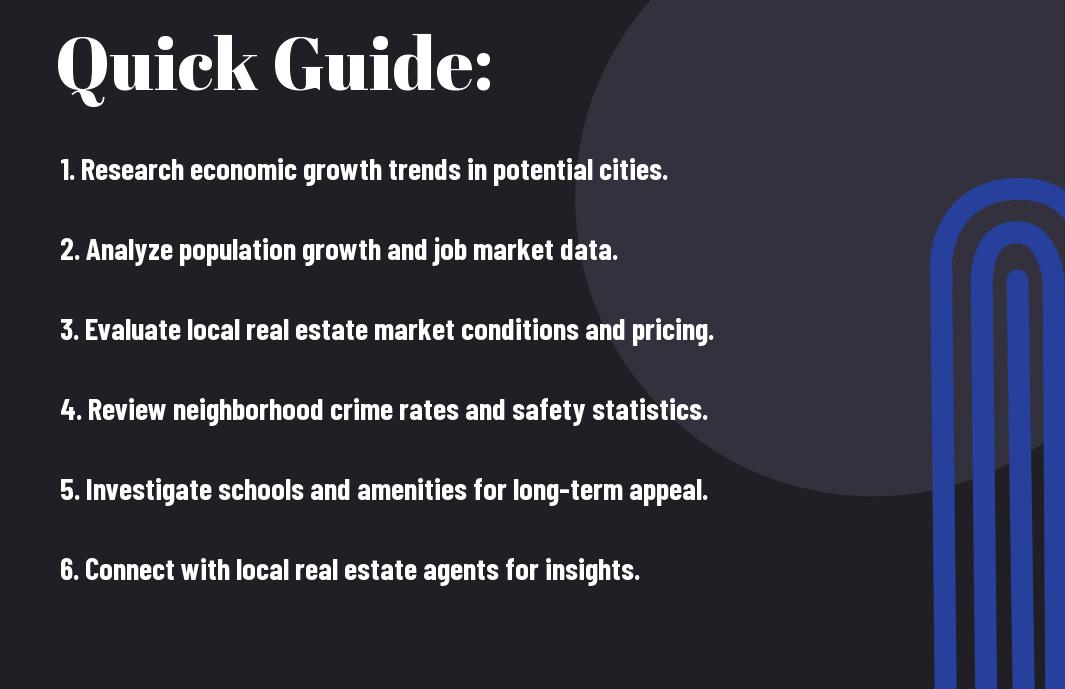Invest in your financial future by identifying the best cities for real estate investment. With the right strategies and insights, you can uncover regions poised for growth and profitability. This guide will lead you through smart how-to steps to evaluate markets, analyze trends, and make informed decisions, ensuring you choose the ideal location for your next investment. By leveraging data and understanding local dynamics, you can maximize your chances of success in the ever-evolving real estate landscape.

Understanding Real Estate Investment
Before initiateing on your real estate investment journey, it’s necessary to understand the different types of investments available to you. Real estate can be a lucrative avenue, but knowing what aligns with your goals will help you make informed decisions. Below is a breakdown of common types of real estate investments:
| Type | Description |
| Residential | Includes single-family homes, apartments, and condos |
| Commercial | Involves office buildings, retail spaces, and warehouses |
| Industrial | Encompasses manufacturing facilities and distribution centers |
| Vacant Land | Unused plots for future development or investment |
| REITs | Investing in real estate investment trusts that manage portfolios of properties |
Any one of these investment types can serve as a building block for your portfolio, depending on your risk tolerance and financial objectives. Understanding the different categories empowers you to choose wisely based on your situation and the market conditions.
Key Factors for Success
For successful real estate investment, you need to focus on key factors that can help you navigate the complexities of the market. Knowing these elements will not only minimize risks but also enhance your potential returns. Keep these factors in mind:
- Market Trends: Stay updated on local market conditions and price movements.
- Location: A prime location often dictates the demand and future value of a property.
- Financing Options: Explore various financing methods to leverage your investments.
- Property Management: Consider how you will manage or maintain your properties.
- Regulatory Environment: Be aware of local zoning laws and compliance requirements.
Thou shall need to systematically evaluate each of these factors when considering an investment. Incorporating a comprehensive approach not only helps in identifying promising investments but also ensures that you’re prepared for any challenges that may arise.
Success in real estate investing doesn’t happen overnight. You must conduct thorough research and be strategic in your decision-making. To boost your chances of achieving successful outcomes in real estate investing, consider the following:
- Networking: Build relationships with other investors and local real estate professionals.
- Due Diligence: Perform detailed property inspections and market analysis.
- Diverse Portfolio: Diversify your investments to spread risk.
- Long-Term Perspective: Focus on long-term value rather than short-term gains.
- Continuous Learning: Stay informed about real estate trends and investment strategies.
Thou must approach real estate investing with a mindset geared toward continuous improvement and strategic growth. By understanding these key factors and implementing effective strategies, you increase your likelihood of achieving significant success in the real estate market.
Step-by-Step Guide to City Selection
Clearly, the process of selecting the best cities to invest in real estate requires a systematic approach. By following specific steps, you can ensure that you make informed decisions that align with your investment goals. The following table outlines key areas to focus on during your city selection process.
| Key Focus Areas | Actions to Take |
|---|---|
| Market Trends | Analyze real estate price fluctuations, rental yields, and foreclosures. |
| Population Growth | Investigate demographic trends and migration patterns. |
| Economic Indicators | Review job growth rates, unemployment statistics, and GDP growth. |
| Neighborhood Dynamics | Examine local amenities, schools, and safety metrics. |
Researching Market Trends
While entering into market trends, one of the first things you should do is track fluctuations in property values over time. Understanding the historical performance of a market can give you insights into its stability and predictability. You should also consider rental yields, as they can provide a clear metric for gauging potential cash flow relative to your investment. It’s also wise to keep an eye on indicators of distress, such as foreclosure rates, to determine whether an area may be experiencing economic challenges.
Analyzing Population Growth
Now, analyzing population growth is equally important when selecting a city for real estate investment. Cities with increasing populations tend to create demand for housing, making them attractive markets for rental properties or sales in the long term. You should investigate census data and local government reports to assess current trends and future projections. Areas with significant population influx often signal economic opportunities, increased job availability, and enhanced demand for housing.
Plus, population dynamics can vary widely across different neighborhoods within a city. Look beyond the surface numbers; consider factors such as age distribution, income levels, and migration patterns. These elements can provide deeper insights into the types of housing that may be in demand, allowing you to tailor your investment strategy accordingly. By thoroughly analyzing these aspects, you increase your chances of identifying promising investment opportunities.
Evaluating Economic Indicators
Once again, when you initiate on your journey to find the best cities for real estate investment, evaluating economic indicators is paramount. This set of data can provide a comprehensive understanding of a city’s financial health and growth potential. A thriving economy often correlates with increased property values and quicker property turnover, allowing for potential profits in your investment endeavors. By analyzing various economic indicators, you can make informed decisions about where to place your resources for the best returns.
Employment Rates and Job Growth
Little can impact a city’s appeal for real estate investment more than its employment rates and job growth. High employment rates indicate a stable economic environment, which is attractive to potential residents and investors alike. Cities that experience significant job growth often see an influx of new residents seeking housing, leading to increased demand for real estate. In addition, local governments typically provide data on job creation and industry diversification, helping you to evaluate the sustainability of the market you’re considering.
Median Income and Affordability
There’s no denying that the median income level and affordability of living in a city will greatly influence your potential returns on real estate investments. Higher median incomes suggest that residents have more disposable income to spend on housing, which can drive prices up while also supporting a rental market with higher rates. Look for cities with growing median incomes paired with reasonable price points; this combination typically signifies a strong demand for housing and good prospects for appreciation.
Economic factors such as median income also provide insight into the purchasing power of residents. When you address affordability alongside median income, you can identify markets where residents are not overextended financially, ensuring a balance between supply and demand. This equilibrium is crucial for a thriving rental market, as individuals in stable financial situations are more likely to invest in housing, whether through buying or renting. Recognizing the dynamics of income and affordability will allow you to ascertain which cities hold the most promise for your real estate investment strategy.
Assessing Neighborhoods
All real estate investors know that the location of your investment can significantly impact its success. When looking at neighborhoods, the assessment of various factors can determine whether you are making a wise decision or if you should seek out a different area. As you dive deeper, it’s crucial to evaluate critical elements such as safety, accessibility to amenities, and overall community vibe, which play vital roles in the desirability of a property.
Safety and Crime Rates
There’s no denying that safety is a fundamental concern for both current residents and potential buyers. Before committing to any investment, you should thoroughly research crime statistics within the neighborhood. Check local police department websites and community forums to get an accurate sense of the prevailing crime rates. A low crime rate often correlates with a stable and thriving community, which can ultimately enhance your property’s value and attract reliable tenants.
Proximity to Amenities
Amenities greatly influence the livability of a neighborhood and, as a result, your potential return on investment. Amenities can range from parks and public transportation to shopping centers and schools. A neighborhood with easy access to these conveniences not only appeals to prospective tenants or buyers but also ensures long-term demand for your property. When you assess this factor, think about how each amenity contributes to the quality of life and how it aligns with your target market.
For instance, if you’re targeting families, proximity to well-rated schools and recreational facilities should be a priority. On the other hand, young professionals may prioritize access to public transit and nightlife options. Tailoring your investment strategy based on the needs and preferences of your target demographic can help you select a neighborhood that supports sustained growth and profitability.
Pros and Cons of Different Cities
Now, when evaluating potential cities for real estate investment, it’s imperative to weigh the pros and cons specific to each location. Each city presents unique opportunities alongside inherent challenges, which can significantly influence your investment decisions. The following table outlines the key advantages and disadvantages you might encounter.
| Pros | Cons |
|---|---|
| Diverse job markets can attract renters. | High competition can drive up property prices. |
| Growing population increases demand. | Economic downturns can impact rental income. |
| Strong appreciation potential in emerging areas. | Potential for increased taxes and regulations. |
| Access to amenities enhances tenant appeal. | Higher maintenance costs in urban areas. |
| Networking opportunities within investor communities. | Risk of over-saturation in desirable locations. |
| Strong transport links enhance accessibility. | Environmental factors, such as crime rates or weather, may deter investments. |
| Opportunities in redeveloping neighborhoods. | Longer timeframes for ROI in development-heavy areas. |
| Potential for multifamily units to generate passive income. | Market volatility can lead to unpredictable fluctuations. |
| Tax incentives in certain locations. | Property management challenges in large cities. |
High-Growth vs. Stable Markets
Pros of investing in high-growth markets include the possibility of significant returns in a short timeframe. These cities often attract young professionals and families, boosting rental demands. Rapidly appreciating property values can lead you to substantial profits when selling investment properties after a few years. However, investing in these areas may come with increased risk due to their volatile nature.
On the other hand, stable markets provide a more predictable investment landscape, characterized by steady rental income and slower but consistent appreciation. These cities may offer long-term security and reliability, making them ideal for those looking for a less risky investment approach. You should consider your investment goals and risk tolerance when deciding between high-growth and stable markets.
Urban vs. Suburban Investments
While urban investments can tap into a dynamic tenant pool with their vibrant job markets and amenities, they come with higher competition and costs. You’ll often encounter properties in high demand, which can lead to increased property values and rental prices. Conversely, suburban investing tends to attract families looking for more space and affordability, often resulting in more stable long-term investments.
For instance, in urban settings, you might benefit from properties with higher turnover, leading to potentially increased cash flow. However, these benefits could be offset by higher costs of doing business and tenant turnover rates. In suburban areas, you often encounter tenants who stay longer, contributing to stable occupancy rates, yet the potential for rapid appreciation may be less dynamic. You should assess these factors carefully based on your investment priorities.
Tips for New Investors
After making the decision to invest in real estate, it’s vital to equip yourself with the right tools and knowledge before diving in. Here are some tips specifically for new investors:
- Conduct thorough market research.
- Set a reasonable budget and stick to it.
- Evaluate different property types for investment.
- Consider working with real estate professionals when necessary.
- Stay updated on market trends and changes.
Perceiving the landscape of real estate investment will position you for success, and understanding the foundational elements can help steer your investment decisions in the right direction.
Building a Reliable Network
Clearly, forging relationships with other investors, real estate agents, and financial advisors can provide valuable insights and guidance. Attend local real estate investment meetings or join online forums where you can both learn and share experiences with other investors. By surrounding yourself with knowledgeable individuals, you can gain access to market opportunities that you may not discover on your own.
Additionally, networking can lead to partnerships that enhance your investment capacity. Whether it’s collaborating on property purchases or sharing market analyses, having a strong network can substantially benefit your overall strategy and execution within the real estate sector.
Utilizing Technology and Data
There’s no denying that technology has transformed the way real estate investors conduct their business. Harnessing the power of data analytics, you can gain insights into market trends, neighborhood statistics, and property values that guide your investment decisions. Use real estate platforms that offer comprehensive data analysis, predictive metrics, and market comparisons to ensure informed choices.
Reliable technology tools can enhance your ability to analyze potential investments efficiently. From leveraging property management software to utilizing geographic information systems (GIS), these resources can help you streamline your processes and save time. You can track market changes in real-time and adjust your investment strategies accordingly. Embracing technology and data will empower you to make better-informed investment decisions and stay ahead of the competition.
Final Words
As a reminder, finding the best cities to invest in real estate requires a comprehensive approach that combines research, analysis, and an understanding of market trends. You should examine various factors such as economic growth, population dynamics, and housing market conditions to identify the most promising locations. Utilizing tools like demographic studies, local property reports, and expert consultations can significantly enhance your decision-making process. Your due diligence will help you spot opportunities that align with your investment goals and minimize risks.
Ultimately, being proactive and strategic in your research will set you apart in the competitive real estate market. By staying informed about emerging trends and access to reliable data, you will be better equipped to make informed investment choices. Keep refining your methods and expanding your knowledge, and you will increase your chances of identifying thriving cities that can contribute positively to your real estate portfolio.



